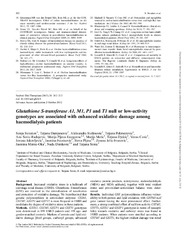Prikaz osnovnih podataka o dokumentu
Glutathione S-transferase A1, M1, P1 and T1 null or low-activity genotypes are associated with enhanced oxidative damage among haemodialysis patients
| dc.creator | Šuvakov, Sonja | |
| dc.creator | Damjanović, Tatjana | |
| dc.creator | Stefanović, Aleksandra | |
| dc.creator | Pekmezović, Tatjana | |
| dc.creator | Savić-Radojević, Ana | |
| dc.creator | Pljesa-Ercegovac, Marija | |
| dc.creator | Matić, Marija | |
| dc.creator | Đukić, Tatjana | |
| dc.creator | Corić, Vesna | |
| dc.creator | Jakovljević, Jovana | |
| dc.creator | Ivanišević, Jasmina | |
| dc.creator | Plješa, Steva | |
| dc.creator | Jelić-Ivanović, Zorana | |
| dc.creator | Mimić-Oka, Jasmina | |
| dc.creator | Dimković, Nada | |
| dc.creator | Simić, Tatjana | |
| dc.date.accessioned | 2019-09-02T11:35:06Z | |
| dc.date.available | 2019-09-02T11:35:06Z | |
| dc.date.issued | 2013 | |
| dc.identifier.issn | 0931-0509 | |
| dc.identifier.uri | https://farfar.pharmacy.bg.ac.rs/handle/123456789/1949 | |
| dc.description.abstract | Background. Increased oxidative stress is a hallmark of end-stage renal disease (ESRD). Glutathione S-transferases (GST) are involved in the detoxification of xenobiotics and protection of oxidative damage. We hypothesized that genetic polymorphism in antioxidant enzymes GSTA1, GSTM1, GSTP1 and GSTT1 is more frequent in ESRD and modulates the degree of oxidative stress in these patients. Methods. GSTA1, GSTM1, GSTP1 and GSTT1 genotypes were determined in 199 ESRD patients and 199 age- and gender-matched controls. Markers of protein and lipid oxidative damage [thiol groups, carbonyl groups, advanced oxidative protein products, nitrotyrosine, malondialdehyde (MDA) and MDA adducts], together with total oxidant status and pro-oxidant antioxidant balance were determined. Results. Individual GST polymorphisms influence vulnerability to both protein and lipid oxidation, with GSTM1-null gene variant having the most pronounced effect. Furthermore, a strong combined effect of null/low-activity GSTM1, GSM, GSTA1 and GSTP1 genotypes in terms of susceptibility towards oxidative and carbonyl stress was found in ESRD patients. When patients were stratified according to GSTM1 and GSTT1, the highest oxidant damage was noted in those with the GSTM1-null/GSTT1-null genotype. The observed effect was even stronger in patients with the third low-activity GSTP1 or GSTA1 genotype. Finally, the level of oxidative and carbonyl stress was most pronounced in the subgroup of patients with all four null or low-activity GSTM1, GSTT1, GSTP1 and GSTA1 genotypes. Conclusions. According to the GST genotype, ESRD patients may be stratified in terms of the level of oxidative and carbonyl stress that might influence cardiovascular prognosis, but could also improve efforts towards individualization of antioxidant treatment. | en |
| dc.publisher | Oxford Univ Press, Oxford | |
| dc.relation | info:eu-repo/grantAgreement/MESTD/Basic Research (BR or ON)/175052/RS// | |
| dc.rights | openAccess | |
| dc.source | Nephrology Dialysis Transplantation | |
| dc.subject | end-stage renal disease | en |
| dc.subject | glutathione S-transferases | en |
| dc.subject | haemodialysis | en |
| dc.subject | oxidative stress | en |
| dc.subject | polymorphism | en |
| dc.title | Glutathione S-transferase A1, M1, P1 and T1 null or low-activity genotypes are associated with enhanced oxidative damage among haemodialysis patients | en |
| dc.type | article | |
| dc.rights.license | ARR | |
| dcterms.abstract | Дамјановић, Татјана; Пекмезовић, Татјана; Јаковљевић, Јована; Матић, Марија; Пљеса-Ерцеговац, Марија; Савић-Радојевић, Aна; Цорић, Весна; Стефановић, Aлександра; Јелић-Ивановић, Зорана; Пљеша, Стева; Димковић, Нада; Иванишевић, Јасмина; Мимић-Ока, Јасмина; Ђукић, Татјана; Шуваков, Соња; Симић, Татјана; | |
| dc.citation.volume | 28 | |
| dc.citation.issue | 1 | |
| dc.citation.spage | 202 | |
| dc.citation.epage | 212 | |
| dc.citation.other | 28(1): 202-212 | |
| dc.citation.rank | M21 | |
| dc.identifier.wos | 000315540100034 | |
| dc.identifier.doi | 10.1093/ndt/gfs369 | |
| dc.identifier.pmid | 23034843 | |
| dc.identifier.scopus | 2-s2.0-84872228525 | |
| dc.identifier.fulltext | https://farfar.pharmacy.bg.ac.rs//bitstream/id/720/1947.pdf | |
| dc.type.version | publishedVersion |

